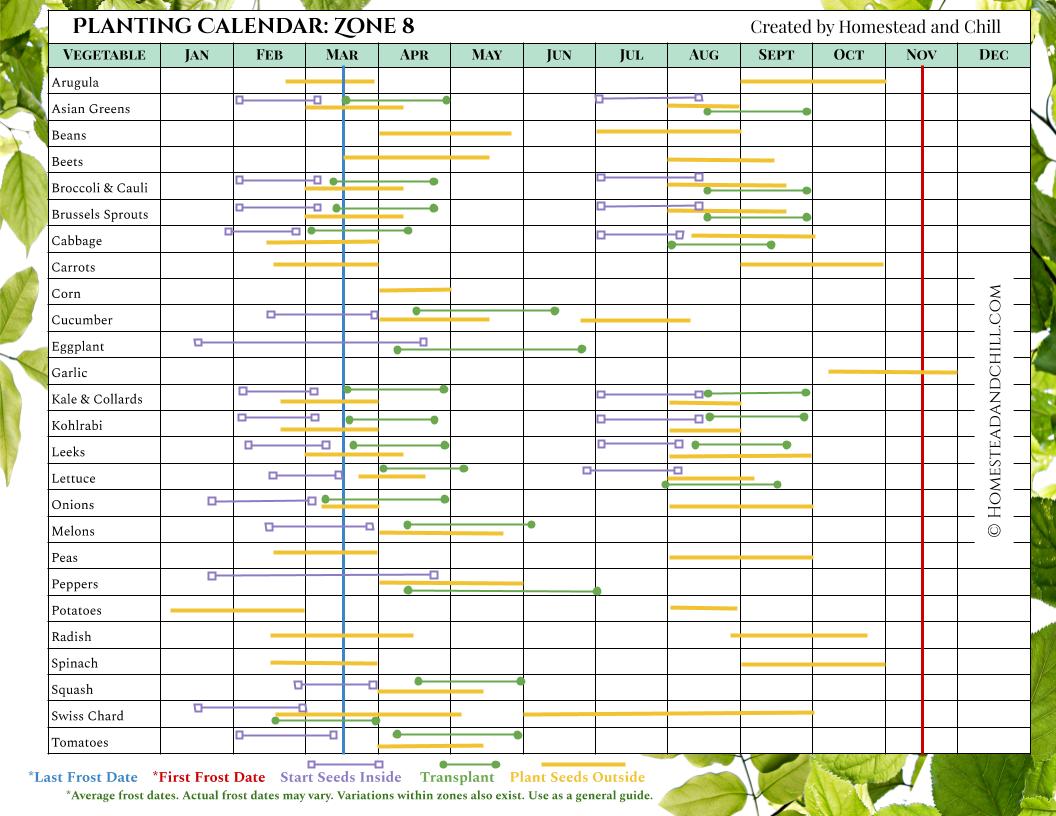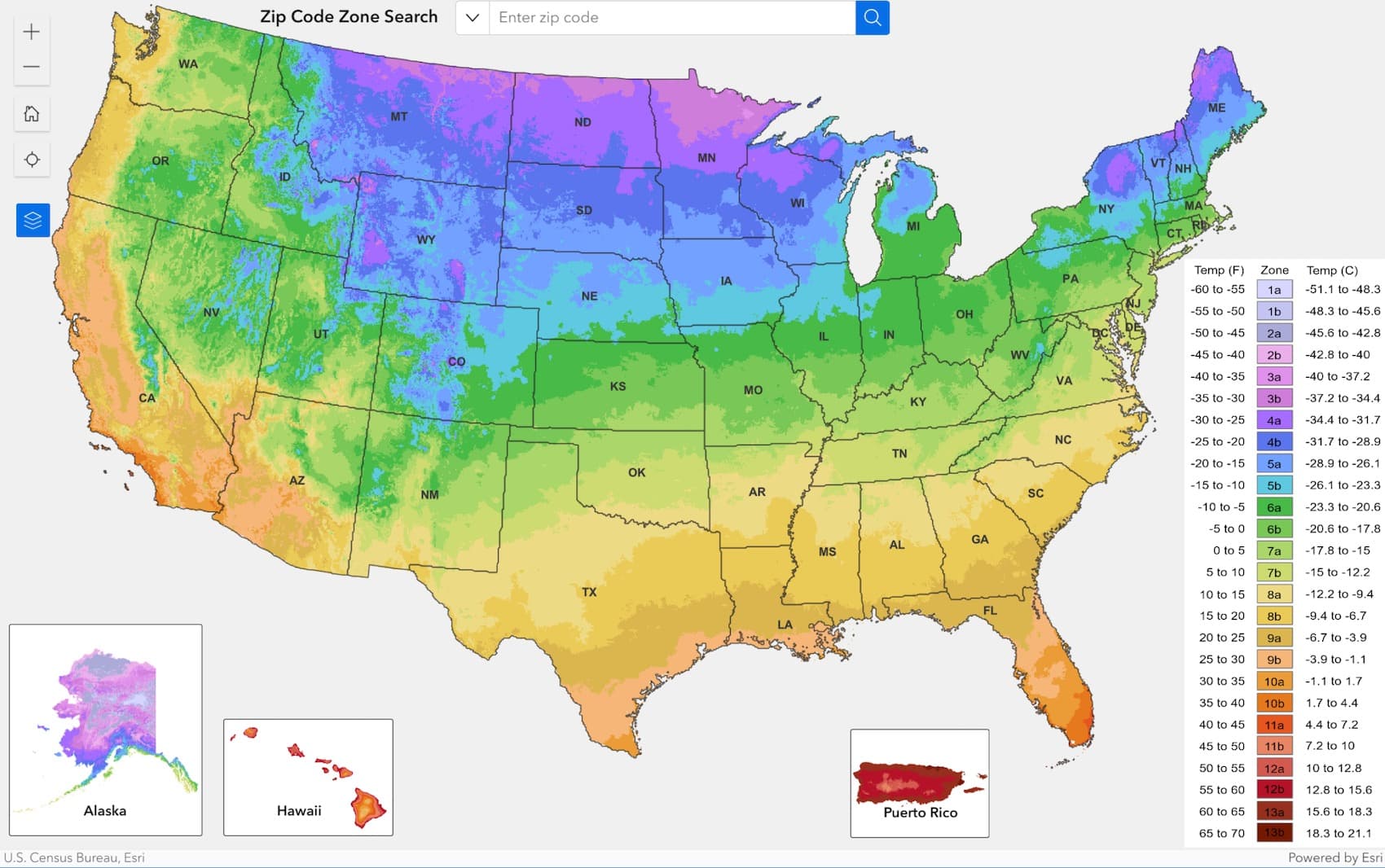New Hardiness Zone Map, Planting Charts, Limitations ~ Homestead and Chill
In the gardening world, you’ll often hear folks talking about their hardiness zones, also known as growing zones or planting zones. It’s an important concept to understand as a gardener, but sometimes not as helpful as you’d think! Truth be told, the zone system has a lot of limitations that often cause confusion. This article will explore what plant hardiness zones are, how to find your growing zone, when they are helpful for gardening, the role of microclimates and chill hours, along with common misconceptions of the zone system.
To account for recent changes in weather patterns (and improved weather station data), the USDA hardiness zone map was recently updated for the first time in over a decade. I’ve included an updated 2023 growing zone map in this post – along with handy planting calendars for every zone. Many areas shifted up by about half a zone. We’re still in the same zone (9) here. Did your garden zone change?
What are Hardiness Zones?
Hardiness zones are established by USDA, where similar growing zones or planting zones are grouped together numerically from 1 to 13. More specifically, hardiness zones are determined by geographical areas with common average low temperatures.
Gardeners use the plant hardiness zone system to help pick and choose which perennial plants are most likely to grow well in their area (i.e. how “hardy” a plant is) and to determine the best time to plant annual crops in the garden.
Each zone is about 10 degrees warmer than the proceeding zone. The lower the zone number, the longer and colder the winters are. Higher growing zones (e.g. 8-11) are generally located in the southern and coastal United States, whereas lower hardiness zones are concentrated in the north and midwest.
Zones are further subdivided by an “A” or “B” classification, such as zone 8a and 8b. There is a 5 degree temperature difference between these sub-zones, with A being the colder of the two. And 5 degrees can make a big difference! Our old homestead was located in 9b/10a and we rarely got frost. Now we are in 9a and get frequent frost along with an occasional hard freeze.


Disclosure: Homestead and Chill is reader-supported. When you purchase through links on our site, we may earn an affiliate commission.
What Growing Zone Am I In?
It’s easy to find your garden hardiness zone with this handy lookup tool. Simply put in your zip code in the top search bar, and it will tell you the growing zone number for your area. You can also get a good idea by looking at the updated hardiness zone map (above), though it can be tough to tell when you’re right on the border of two zones.
When Hardiness Zones are Helpful for Gardening
In the Landscape
Knowing your hardiness zone is incredibly helpful when choosing plants for your garden, particularly for perennials or permanent landscape plants such as trees, fruit trees, and shrubs.
A plant’s hardiness zone compatibility is usually listed in the plant description, such as online or on the plant’s tag. For example, the blueberry bush shown below says it is rated down to zone 5. That’s essentially saying “this plant can survive the winter in zone 5 or higher”.
Choosing native plants for your landscape is even better than looking at zone compatibility alone, since those species will be well-adapted to other local factors like heat and rainfall patterns.
In the Vegetable and Flower Garden
Hardiness zones aren’t usually listed for annual crops like vegetables or flowers, since gardeners don’t have to worry about these short-lived plants surviving through winter. However, garden zones greatly influence when to start seeds, plant seedlings outside, and what varieties to grow!
In addition to average low temperatures, growing zones often share common first and last frost dates. Though they can vary slightly by unique microclimates or year-to-year, average frost dates can serve as a general guide as to when it’s safe to plant certain vegetables and flowers outside. Most flower and veggie seed packets also have instructions such as “start seeds 8 weeks before last spring frost date”.
To make things simple, we’ve created garden planting charts for every hardiness zone! See an example below, and find the right planting calendar for your zone here.


Finally, growing zones can dictate what varieties of vegetables will grow best in your garden. Folks in lower garden zones with short growing seasons may want to choose varieties with fewer “days to maturity” so the crop will ripen fast enough to be ready for harvest before fall frost arrives.
Take butternut squash for example. This Honey Nut variety of butternut requires 110 days to mature and harvest, while this Nutter Butter variety only needs 90 days – nearly a month sooner! Other crops like cabbage have even more variation, ranging from 60 to 100 days depending on the cultivar.


Limitations and Issues with Plant Hardiness Zones
The biggest limitation with the USDA hardiness zones system is that it only accounts for average low temperatures. That’s it. Meaning, plant hardiness zones DO NOT take into account high temperatures, humidity, rainfall, altitude, daylight hours (latitude) or other climatic variables between regions – all of which can have significant impact on how plants grow, or how we care for them!
For example, our garden is located on the temperate Central Coast of California in growing zone 9. Here, we get a lot of summer fog, cool breezes, and little-to-no rain spring through fall. Our summer high temperatures rarely exceed 80 to 85°F. Yet Phoenix Arizona, with its blistering hot and dry summers, is also located in garden zone 9! As are many parts of sweltering, wet, and muggy Florida and Texas. Hard winter freezes are rare in all these zone 9 locations, but our summers couldn’t be more different.
Just because a plant may be “rated” to grow in a certain garden zone, doesn’t mean it will perform well.
For instance, tropical mangoes are rated for growing zones 9 through 11, but they need a good deal of summer heat to get ripe and sweet. So despite the fact we’re in hardiness zone 9, our summers are simply too mild and cool for mangoes to thrive here on the central coast.
On the other hand, things that grow well in our temperate zone 9 climate may totally fry in the heat of Texas or Arizona zone 9! Or, plants that prefer dry soil (like lavender) may do well in arid zone 9 areas, but struggle in wet and humid zone 9 areas like Florida.


Microclimates Within Growing Zones
The updated 2023 USDA plant hardiness map is scaled to about a half a mile radius, while the old 2012 map grouped similar growing zones within 5 miles. Even with the updated precision, a lot can vary within a half a mile, neighborhood, or even within a single yard!
Unique variations within a planting zone are referred to as microclimates. Microclimates can have a significant impact on sun exposure, temperature, frost risk, wind, precipitation and more.
For example, a garden on top of a sunny hill is going to experience very different growing conditions than their neighbor at the bottom of the hill, tucked in a shady valley. Similarly, a garden or tree planted near the protection of a house, wall, or fence will be exposed to different conditions than if planted out in an open field.
That said, it’s important to be keen to the microclimates in your yard and garden. Some could even bump that area into a different growing zone entirely! Microclimates can work both to your disadvantage (e.g too much shade) or to your advantage, such as sheltering plants from unfavorable temperature extremes.
Soon after moving to our new homestead, we noticed our property always seemed to be several degrees warmer or colder than the local weather forecast. So much so, it led to unexpected hard freezes that killed some of our plants! So, we invested in this personal home weather station to better learn and monitor the microclimate of our garden, as well as track precipitation. I absolutely love it.
Plant Hardiness Zones vs. Chill Hours
When choosing fruit trees for your garden, chill hours are an essential factor to consider beyond hardiness zones. Most fruit trees require a certain number of chill hours (those between 32 and 45°F) in order to break dormancy, properly flower and bear fruit. Chill hour requirements vary by type of fruit tree AND variety. Learn more about chill hours here.
Let’s consider apples for example – who love colder weather. Honeycrisp apples are technically rated to grow in zones 4 to 9. Again, that simply means the trees will survive the winter in those zones… but it doesn’t mean they’ll perform well! Honeycrisp apples are considered a “high chill” apple, and require 800-1000 chill hours to bear fruit. Our zone 9 location only receives 400-500 chill hours. If we chose to plant a Honeycrisp tree based on zone compatibility alone, we’d be sorely disappointed with our lack of apples! We don’t get enough chill hours for it to bear fruit well.
NOTE: Fruit trees often need a partner tree for cross-pollination too! Learn more about fruit tree growing requirements here.
Stretching Garden Zones
Even if a plant isn’t perfectly suited for your growing zone or climate, there are a lot of measures gardeners can take to “stretch the zones” and help plants survive despite less-than-ideal conditions.
- Compared to planting seeds directly outside, starting seeds indoors (or planting nursery seedlings) gives gardeners a head start on the growing season by several months.
- In hot climates or during heat waves, the use of shade cloth can help shield heat sensitive plants and keep them healthy. Shade cloth can be draped over individual garden beds, or hung high across an entire garden space. See 6 ways to protect plants from heat here.
- Cold-climate gardeners often make use of greenhouses, cold frames or cloches to extend the growing season in both directions.
- Use frost cloth over garden beds, around fruit trees, shrubs, or other tender ornamental plants during a frost or hard freeze that may otherwise harm them. Learn 7 ways to protect plants from frost here.
- It’s possible to create a microclimate in your own yard. For instance, planting a sensitive tree or shrub near a wall, fence, or another large tree will keep it several degrees warmer than if it were planted out in the open.






And that’s the basics of plant hardiness zones.
All in all, plant hardiness zones can help serve as a general guide for choosing plants and schedules. Yet as you now see, zones are not the definitive end-all-be-all answer to garden planning and success! Hopefully this article helped to illuminate the limitations of the planting zone system, but also gave you plenty of tips to better work around them. Please feel free to ask questions in the comments below, and consider pinning or sharing this post if you found it useful!
Don’t miss these related articles:









